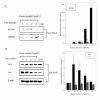The conformation change of Bcl-2 is involved in arsenic trioxide-induced apoptosis and inhibition of proliferation in SGC7901 human gastric cancer cells
- PMID: 20403207
- PMCID: PMC2873337
- DOI: 10.1186/1477-7819-8-31
The conformation change of Bcl-2 is involved in arsenic trioxide-induced apoptosis and inhibition of proliferation in SGC7901 human gastric cancer cells
Abstract
Background: Arsenic trioxide has been established as a first-line agent for treating acute promyelocytic leukemia. Experimental data suggest that arsenic trioxide also can have a potential use as chemotherapeutic agent for other malignancies. The precise mechanisms of action of arsenic trioxide have though not been elucidated. As the role of Bcl-2 in arsenic trioxide-mediated cell apoptosis and conformation change of Bcl-2 in response to arsenic trioxide treatment has not been studied. The aim of the present study was to determine whether conformation change of Bcl-2 is involved in the action of arsenic trioxide.
Methods: Human gastric cancer SGC7901 cells were exposed to different concentrations of arsenic trioxide. Proliferation was measured by using the Kit-8 cell counting assay. Analysis of nuclear morphology was observed by DAPI staining. The apoptosis rates of cells treated with arsenic trioxide were analyzed by flow cytometry using Annexin V-FITC staining. The conformation change of Bcl-2 and Bax activation were detected by immunostaining and Western blot analysis. Total expression of Bcl-2 and Bax were examined by Western blot analysis.
Results: Arsenic trioxide inhibited the growth of human gastric cancer SGC7901 cells and induced apoptosis. There were two Bcl-2 phenotypes coexisting in SGC7901 cells and the Bcl-2 cytoprotective phenotype could change into a cytodestructive phenotype following conformational change of Bcl-2, triggered by arsenic trioxide exposure. Bax activation might also be involved in arsenic trioxide-induced Bcl-2 conformational change. Arsenic trioxide did not change levels of total Bcl-2 expression, but up-regulated total Bax expression for the treatment time ranging from 3 to 24 hours.
Conclusion: Arsenic trioxide induces apoptosis through induction of Bcl-2 conformational change, Bax activation and up-regulation of total Bax expression rather than affecting total Bcl-2 expression in human gastric cancer SGC7901 cells. The conformational change of Bcl-2 may be a novel described mechanism of arsenic trioxide-induced apoptosis in cancer cells.
Figures



Similar articles
-
[Arsenic trioxide induced apoptosis in retinoblastoma cells in vitro and its possible mechanism].Zhong Nan Da Xue Xue Bao Yi Xue Ban. 2008 Jun;33(6):476-80. Zhong Nan Da Xue Xue Bao Yi Xue Ban. 2008. PMID: 18599993 Chinese.
-
Arsenic trioxide causes redistribution of cell cycle, caspase activation, and GADD expression in human colonic, breast, and pancreatic cancer cells.Cancer Invest. 2004;22(3):389-400. doi: 10.1081/cnv-200029068. Cancer Invest. 2004. PMID: 15493360
-
Expression of AFP and STAT3 is involved in arsenic trioxide-induced apoptosis and inhibition of proliferation in AFP-producing gastric cancer cells.PLoS One. 2013;8(1):e54774. doi: 10.1371/journal.pone.0054774. Epub 2013 Jan 30. PLoS One. 2013. PMID: 23382965 Free PMC article.
-
Arsenic-induced apoptosis in malignant cells in vitro.Leuk Lymphoma. 2000 Mar;37(1-2):53-63. doi: 10.3109/10428190009057628. Leuk Lymphoma. 2000. PMID: 10721769 Review.
-
Arsenic trioxide and neuroblastoma cytotoxicity.J Bioenerg Biomembr. 2007 Feb;39(1):35-41. doi: 10.1007/s10863-006-9058-6. J Bioenerg Biomembr. 2007. PMID: 17549641 Review.
Cited by
-
Study of conformational changes and protein aggregation of bovine serum albumin in presence of Sb(III) and Sb(V).PLoS One. 2017 Feb 2;12(2):e0170869. doi: 10.1371/journal.pone.0170869. eCollection 2017. PLoS One. 2017. PMID: 28151990 Free PMC article.
-
Cardioprotective potential of polyphenols rich Thraatchathi Chooranam against isoproterenol induced myocardial necrosis in experimental rats.BMC Complement Med Ther. 2020 Nov 23;20(1):356. doi: 10.1186/s12906-020-03124-x. BMC Complement Med Ther. 2020. PMID: 33225920 Free PMC article.
-
Arsenic Trioxide Affects the Proliferation of Gastric Cancer Cells through MiR-885-5p/CDC73 Axis.Iran J Public Health. 2023 Jan;52(1):128-137. doi: 10.18502/ijph.v52i1.11674. Iran J Public Health. 2023. PMID: 36824234 Free PMC article.
-
Current Advances of Nanomedicines Delivering Arsenic Trioxide for Enhanced Tumor Therapy.Pharmaceutics. 2022 Mar 30;14(4):743. doi: 10.3390/pharmaceutics14040743. Pharmaceutics. 2022. PMID: 35456577 Free PMC article. Review.
-
Role of the transient receptor potential melastatin 4 in inhibition effect of arsenic trioxide on the tumor biological features of colorectal cancer cell.PeerJ. 2024 Jun 4;12:e17559. doi: 10.7717/peerj.17559. eCollection 2024. PeerJ. 2024. PMID: 38854798 Free PMC article.
References
-
- Miller WH Jr, Schipper HM, Lee JS, Singer J, Waxman S. Mechanisms of action of arsenic trioxide. Cancer Res. 2002;62(14):3893–3903. - PubMed
-
- Soignet SL, Frankel SR, Douer D, Tallman MS, Kantarjian H, Calleja E, Stone RM, Kalaycio M, Scheinberg DA, Steinherz P, Sievers EL, Coutré S, Dahlberg S, Ellison R, Warrell RP Jr. United States multicenter study of arsenic trioxide in relapsed acute promyelocytic leukemia. J Clin Oncol. 2001;19(18):3852–3860. - PubMed
-
- Murgo AJ, McBee WL, Cheson BD. Clinical trials referral resource. Clinical trials with arsenic trioxide. Oncology (Williston Park) 2000;14(2) 206, 211, 215-206 passim. - PubMed
Publication types
MeSH terms
Substances
LinkOut - more resources
Full Text Sources
Medical
Research Materials

